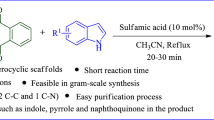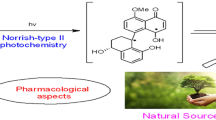Abstract
With phosphonoformic acid (PFA) and its analog, phosphonoacetic acid (PAA), as the lead compounds, α-amino phosphonates were introduced into PFA and PAA. The derivatives of N-(alkoxycarbonyl-alkoxyphosphonyl)-α-amino phosphonates (I) and N-(alkoxycarbonyl-methyl-alkoxyphosphonyl)-α-amino phosphonates (II) with the N-terminal of amino phosphonates bonding to phosphorus atom of PFA andPAA were synthesized via the reaction of the corresponding phosphonyl chloride with α-amino phosphonates in the presence of a base. The31P NMR spectra of I and II were determined. It is found that the coupling constants3 J pp with R3 being alkyl group were lower than those with R3 being (substituted) phenyl, and this result was discussed. The preliminary bioassay showed that some of the compounds I and II have better activities against tobacco mosaic virus (TMV). The inhibitory was higher than that of DHT (2, 4-dioxyhexahydro-1, 3, 5-triazine). In addition, some of the compounds showed the activity against cancer cells.
Similar content being viewed by others
References
Oberg, B. O., Antiviral effects of phosphonoformate (PFA foscarnet sodium),Pharmacol Ther., 1989, 40(2): 213.
Wamberg, M. A., Kendall, O., Gilmore, N., Vaccine and antiviral strategies against infections caused by human immunodeficiency virus,Can. Med. Asm. J., 1988, 138(9): 797.
Swenson, C. L., Polas, P. J., Weisbrode, S. E.et al., Prophylactic efficacy and bone toxicity associated with phosphonofor mate therapy against retrovirus infection,Antiviral Chem Chemother., 1992, 3(6): 335.
Kafarski, P., Lejczak, B., Biological activity of aminophosphonic acids,Phosphorus Sulfur Silicon and Relat Elem, 1991, 63(1–2): 193.
Bucha, H. C., Langsdorf, W. P., Di(hydrocarbyl) carbamoylphosphonate plant growth regulantors,US Patent 3849102, 1974-11-19.
Chen Ruyu, Li Huiying, Ren Kangtai, Studies on Naryl-isopropylcarbamoyl methyl phosphonamidates,Chem J Chinese Univ. (in Chinese), 1995, 16(10): 1577.
Gallagher, J. G., Webb, R. L., Tetrasubstituted acrylates: the Wittig -Homer reaction of ketones with triethyl α-phosphono-propionate,Synthesis, 1974, (2) 122.
Oleksyszyn, J, Subotkowska, L., Mastalen.P., Diphenyl 1-aminoalkanephosphonates,Synthesis, 1979, (12): 985.
Kingsbury, C. A., Thoennes, D., Conformation and configuration of diastereomeric phosphine oxides,Tetrahedron Lett. 1976, (35): 3037.
Quin, L. D., Gallagher, M. J., Cunhle, G. T.et al.,31P and13C NMR spectra of 2-norbornyl phosphorus compounds: Karplus equations for3Jpc in several P (III) and P (IV) derivatives,J Am Chem Soc., 1980, 102(9): 3136.
Chen Ruyu, Li Huiying, Synthesis of N-(methoxycarbonyl or isopropylcarbarnoyl-methoxyphosphonyl)-α-amino acid esters and their stereomers,Science in China, Ser. B, 1996, 39(4): 371.
Author information
Authors and Affiliations
Additional information
Project supported by the National Natural Science Foundation of China.
Rights and permissions
About this article
Cite this article
Li, H., Chen, R. & Ren, K. Synthesis of N-(alkoxycarbonyl or alkoxycarbonyl-methyl-alkoxyphosphonyl)-α-amino-O, O-diphenyl phosphonates and their bioactivities. Sc. China Ser. B-Chem. 40, 365–372 (1997). https://doi.org/10.1007/BF02877752
Received:
Revised:
Issue Date:
DOI: https://doi.org/10.1007/BF02877752




